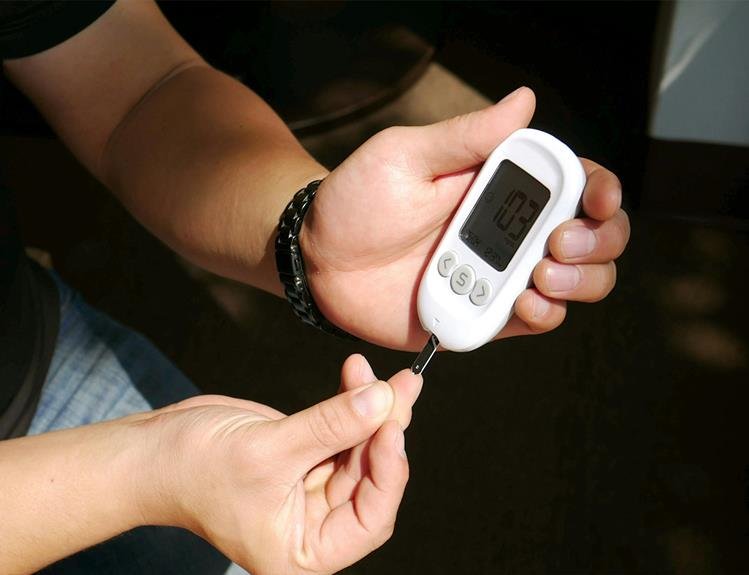Diabetic Foot Care: Tips to Avoid Amputation
Maintaining healthy feet is crucial for individuals with diabetes, as neglecting proper foot care can lead to severe complications. Daily inspections and good hygiene practices are just the beginning. Choosing suitable footwear, managing blood sugar levels, and regular podiatrist visits are key.
However, the real game-changer lies in preventing and treating foot ulcers effectively. Immediate wound care can make all the difference in preserving your mobility and avoiding drastic measures. Your feet deserve the best care possible; let's explore how you can safeguard them.
Understanding Diabetic Foot Complications
To understand diabetic foot complications, monitor your blood sugar levels regularly. Consistently high blood sugar levels can lead to nerve damage and poor circulation, increasing the risk of foot problems. Nerve damage, known as neuropathy, can cause numbness, tingling, or pain in your feet, making it difficult to detect injuries. Poor circulation affects the healing process, making even minor cuts or blisters more susceptible to infection.
Moreover, untreated foot complications can escalate quickly in individuals with diabetes. Without proper care, small issues like blisters or ingrown toenails can progress to serious infections or ulcers. These ulcers, if left unattended, can lead to tissue damage and in severe cases, may necessitate amputation. Understanding the impact of uncontrolled blood sugar levels on your feet is crucial in preventing diabetic foot complications.
Importance of Daily Foot Inspections
Regularly inspecting your feet daily is crucial for individuals with diabetes to prevent potential complications. By conducting daily foot inspections, you can catch any issues early on before they escalate into more serious problems. Check for any cuts, sores, blisters, redness, swelling, or signs of infection.
Use a mirror or ask for assistance if you have trouble seeing the bottom of your feet. Pay close attention to any changes in temperature or sensation in your feet. Look out for ingrown toenails, corns, or calluses that could lead to ulcers.
If you notice anything out of the ordinary during your foot inspection, seek medical advice promptly. Remember that early detection and intervention can help prevent diabetic foot ulcers and infections.
Proper Foot Hygiene Practices
Maintaining proper foot hygiene is essential for individuals with diabetes to prevent infections and complications.
To start, wash your feet daily with warm water and mild soap, ensuring to dry them thoroughly, especially between the toes.
Moisturize your feet, but avoid applying lotion between the toes to prevent excess moisture buildup.
Trim your toenails straight across to avoid ingrown nails, and file any sharp edges gently.
It's crucial to inspect your feet daily for any cuts, sores, or blisters, and seek medical attention if you notice any signs of infection.
Wear clean socks made of breathable materials and change them daily.
Avoid walking barefoot to prevent injuries, and opt for comfortable shoes that provide ample support and room for your toes.
Choosing the Right Footwear
Selecting appropriate footwear is crucial for individuals with diabetes to ensure proper foot health and prevent complications. When choosing shoes, opt for styles that provide ample support and cushioning to reduce pressure on your feet. Look for shoes with soft, seamless interiors to prevent rubbing and irritation that could lead to ulcers. Additionally, ensure that your footwear fits well without being too tight or too loose, as improper fit can cause blisters or calluses.
Avoid high heels, pointed toes, and shoes with seams inside that can cause friction. Instead, opt for shoes with a wide toe box to prevent crowding of the toes. Consider specialized diabetic shoes that are designed to reduce pressure points and provide extra support. Remember to inspect your shoes regularly for any signs of wear and tear, as damaged footwear can increase the risk of foot injuries.
Managing Blood Sugar Levels
To effectively manage your blood sugar levels as a person with diabetes, maintaining a balanced diet and monitoring your glucose regularly are key components of your daily routine. Eating a variety of nutrient-dense foods such as fruits, vegetables, whole grains, lean proteins, and healthy fats can help stabilize your blood sugar levels. Avoiding sugary drinks and excessive carbohydrates is crucial in managing your diabetes effectively. Additionally, portion control plays a significant role in regulating blood sugar levels, so be mindful of your serving sizes.
Regular physical activity is also essential for controlling blood sugar levels. Exercise helps your body use insulin more efficiently, which can lower your blood sugar levels. Aim for at least 30 minutes of moderate exercise most days of the week. Remember to consult your healthcare provider before starting any new exercise routine.
Regular Visits to a Podiatrist
You should prioritize scheduling regular check-ups with a podiatrist to ensure your diabetic foot care remains on track.
These visits are essential for early detection of any potential issues and for implementing preventative care measures.
Importance of Check-Ups
Regular check-ups with a podiatrist play a crucial role in diabetic foot care. These appointments are essential for monitoring your foot health, especially if you have diabetes. A podiatrist can detect any potential issues early on, such as nerve damage or poor circulation, which are common complications for diabetic individuals.
Through regular check-ups, your podiatrist can provide personalized care and advice based on the specific needs of your feet. They can also help you manage any existing foot problems before they escalate, potentially preventing serious complications like infections or ulcers that could lead to amputation.
Preventative Care Measures
Scheduling regular visits to a podiatrist is key in maintaining optimal foot health for individuals with diabetes. A podiatrist can provide specialized care, conduct thorough examinations, and offer personalized advice to help you manage your condition effectively. During these visits, the podiatrist will assess your foot health, check for any signs of complications such as ulcers or nerve damage, and recommend appropriate treatments.
Early detection of foot problems is crucial in preventing serious complications that could lead to amputation. By establishing a consistent schedule of visits to your podiatrist, you can stay proactive in caring for your feet and ultimately reduce the risk of severe diabetic foot complications. Make sure to prioritize these appointments for the overall health of your feet.
Preventing and Treating Foot Ulcers
To prevent foot ulcers, ensure proper foot hygiene and inspect your feet daily for any signs of redness, blisters, or cuts. If you notice any issues, seek prompt treatment from a healthcare professional to avoid complications.
Effective ulcer treatments may include wound care, antibiotics, off-loading pressure, and other specialized interventions.
Ulcer Prevention Techniques
Properly caring for your feet plays a crucial role in preventing and treating foot ulcers.
To prevent ulcers, ensure you inspect your feet daily for any redness, blisters, or cuts. Keep your feet clean and moisturized, but make sure to dry them thoroughly, especially between the toes. Trim your toenails carefully and avoid cutting them too short.
Always wear well-fitting shoes and clean socks to protect your feet from friction and pressure. Avoid walking barefoot and check the insides of your shoes for any foreign objects before wearing them.
Lastly, maintain good blood sugar control and follow your healthcare provider's advice for managing your diabetes to reduce the risk of developing foot ulcers.
Effective Ulcer Treatments
To effectively prevent and treat foot ulcers, it's essential to implement proper wound care techniques and adhere to recommended treatment regimens.
For effective ulcer treatment, cleaning the wound with mild soap and water, applying antibiotic ointment, and covering it with a sterile bandage are crucial steps. Keep weight off the affected foot to prevent further damage and promote healing.
Regularly changing dressings and monitoring the wound for signs of infection, such as increased redness, swelling, or pus, are vital. Additionally, following your healthcare provider's instructions for medication and attending scheduled appointments for wound assessment is essential.
Importance of Immediate Wound Care
Respond promptly to any wounds on your diabetic feet to prevent complications and promote faster healing. Immediate wound care is crucial in diabetic foot management.
Clean the wound gently with mild soap and water, then cover it with a sterile bandage to prevent infection. Regularly changing the dressing and keeping the area clean and dry speeds up the healing process.
Monitoring the wound for any signs of infection such as increased pain, redness, swelling, or drainage is essential. If you notice any of these symptoms, seek medical attention promptly to prevent further complications.
Remember, even small wounds can quickly escalate into serious issues for diabetic individuals. By addressing wounds promptly, you can reduce the risk of infections, ulcers, and potential amputations.
Your diligence in caring for wounds on your diabetic feet plays a significant role in maintaining your overall foot health and preventing long-term consequences.
Frequently Asked Questions
Can Diabetic Foot Complications Be Reversed With Proper Care and Treatment?
With proper care and treatment, diabetic foot complications can be managed effectively. Regular monitoring, maintaining healthy blood sugar levels, wearing appropriate footwear, and seeking prompt medical attention for any issues are crucial steps in preventing severe complications.
Are There Any Specific Exercises or Stretches That Can Help Improve Circulation in Diabetic Feet?
To help improve circulation in your diabetic feet, consider simple exercises like ankle pumps and toe wiggles. These movements can enhance blood flow and promote better foot health. Incorporate them into your daily routine for optimal benefits.
How Often Should Diabetics Have Their Feet Professionally Assessed by a Podiatrist?
You should have your feet professionally assessed by a podiatrist at least once a year. Regular check-ups can help identify any issues early and prevent complications. Make it a priority for better foot health.
Are There Any Alternative Treatments or Therapies That Can Help Prevent Diabetic Foot Ulcers?
To prevent diabetic foot ulcers, you can explore alternative treatments like acupuncture, hyperbaric oxygen therapy, or advanced wound dressings. Consult with your healthcare provider to discuss these options and determine the best course of action for you.
Can Wearing Compression Socks or Stockings Help With Diabetic Foot Complications?
Wearing compression socks can work wonders for diabetic foot complications. They help improve circulation, reduce swelling, and provide extra support. It's like giving your feet a comforting hug all day long. Remember to choose the right fit!
Conclusion
So, remember, taking care of your diabetic feet is crucial if you want to avoid amputation.
It's as easy as checking your feet daily, keeping them clean, wearing the right shoes, and keeping your blood sugar levels in check.
Oh, and don't forget to see a podiatrist regularly and treat any ulcers immediately.
Because, you know, losing a foot is definitely not on your to-do list.





